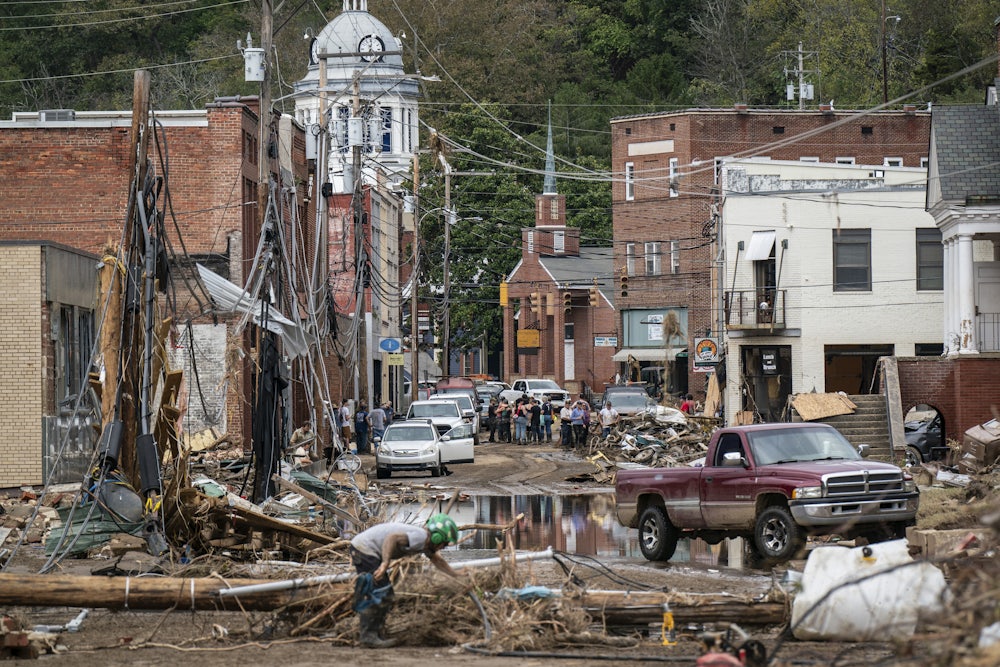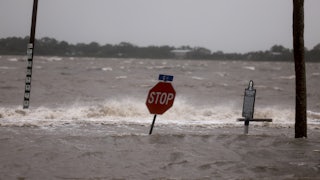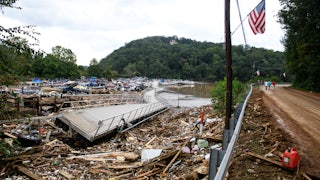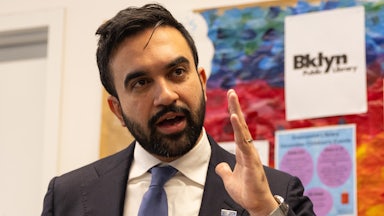As people across the Southeast continue to pick up the pieces from Hurricane Helene, many will continue to face a rude awakening: that they—or their landlords—don’t have flood insurance. Those facing damages from winds or mudslides are more likely to be covered, since that type of damage is included in many basic home insurance packages. But policyholders shelling out potentially record sums for that coverage may still only see a fraction of what repairs, replacement, and rebuilding will actually cost.
Hurricane Helene crashed into an insurance sector facing a series of potentially existential questions, and a policy landscape in which the United States has left key decisions about how communities prepare for and recover from disasters in the hands of companies that exist to turn a profit—not provide protection. “Right now, we’re essentially leaving all of these decisions about land use and where risk mitigation happens up to insurance companies,” says Moira Birss, a longtime organizer and fellow at the Climate & Community Institute.
Preventative risk reduction—for example, raising low-lying coastal homes up on on stilts—can offer as much as $13 in savings on disaster losses for every dollar spent, according to one 2019 study from the National Institute of Building Sciences. The burden of making those sorts of changes often falls largely on individual homeowners. “Maybe your insurance company tells you directly, or your prices are rising and you get the message to put on a new roof or trim the trees around your house,” Birss told me. The problem is that a lot of people don’t have the money up-front to make those kinds of changes.”
The cost of home insurance in the U.S. has increased by roughly 20 percent over the last two years and is on track to reach new highs in 2024. The consequences of that extend well beyond individual policyholders. Affordable housing developers—already discriminated against by insurance providers—have been forced to delay and cancel projects amid skyrocketing premiums. In some cases they can’t even get a quote. Between 2022 and 2023, nearly 30 percent of the 400 affordable housing companies surveyed by the National Leased Housing Associations—a trade association for those developers—saw premiums increase by at least 25 percent, leading many to raise rents and cut costs. More than half of renters nationwide now hand at least 30 percent of their income over to landlords each month, meaning that home insurance increases are now exacerbating the crisis in affordable housing for renters too.
Those pressures are especially intense in some of the areas worst hit by Hurricane Helene. That includes famously red-hot housing markets in South Florida, but also the more temperate, mountainous regions of North Carolina and Tennessee that were hammered with as much as two feet of rainfall over the weekend. Between 2015 and 2021, the median rent in Asheville increased by 33 percent; wages in the city’s biggest industries only grew by 15 percent. Median home values nearly doubled over the same time period, jumping from $199,800 to $319,400. Many of those living in Helene’s 800-mile path of destruction—whether renters or homeowners—may not be able to afford to move back.
“It’s usually not build back better. It’s usually build back bougie,” says Zac Taylor, assistant professor in the Department of Management in the Built Environment at Delft University of Technology. “It’s the up-front mitigation,” especially oft-neglected larger-scale efforts like updating public infrastructure and building codes, “that really mitigates the risk of a market-driven fallout after the fact.”
The situation in Appalachia could be especially dire. Despite the fact that home insurance packages are marketed under names like “all peril,” those policies generally don’t include flood insurance. That’s typically provided by the country’s only public insurance program: the National Flood Insurance Program, administered by the Federal Emergency Management Agency, or FEMA. Just 4 percent of homeowners have flood insurance, nationwide, and they’re typically near large bodies of water; as few as 2.4 percent of homes in the areas hit by Helene are estimated to have coverage.
People looking to buy houses in FEMA-designated “special flood hazard areas” are typically required to get flood insurance coverage in order to secure a loan from the federally backed mortgage lender. Those maps are notoriously out of date. Not everyone who buys a house takes out a mortgage, either. And while lenders would seem to have a built-in incentive to ensure that homes on their books aren’t catastrophically inundated, flood insurance policies often lapse after a few years—potentially because banks often securitize those mortgages and sell them off to investors as complex financial products.
“It’s a perfectly plausible interpretation on the part of a homeowner in inland North Carolina to think, ‘I’m not in a flood zone, and I’m not required to have a flood insurance policy so therefore I must be safe,” says Rebecca Elliott, an associate professor of sociology at the London School of Economics and Political Science and the author of Underwater: Loss, Flood Insurance, and the Moral Economy of Climate Change in the United States. “When a storm like Helene hits, the fact that they are not becomes so obvious so quickly.”
As the full picture of the damage across rain-ravaged parts of Appalachia becomes clear, she says, “I think what we’re going to find is that many people are going to have nothing to rebuild with aside from what they can scrounge together from their own savings.”
Birss and Taylor are both among the co-authors of a new report from the Climate & Community Institute that recommends the creation of Housing Resilience Agencies, “state-level entities with democratic governing structures and public risk modeling that would be tasked with studying and determining where community-oriented and comprehensive risk reduction should happen,” Birss explains.
Rather than continuing to leave critical planning decisions up to the insurance industry, HRAs would provide public disaster insurance—filling the considerable gaps in private-sector coverage—and coordinate comprehensive disaster risk-reduction activities, taking the burden off individuals to “harden” their homes against worsening extreme weather events. The idea, Taylor tells me, is to “make sure we’re deploying resources to de-risk communities before storms. Prevention is the strongest way of getting ahead of this problem. Prevention can look like all sorts of different things: from building infrastructure to hardening assets,” including homes and businesses. “Maybe it means selective managed retreat. But it means really reducing the harm before it happens.” Supplemental public insurance would provide coverage to multifamily housing providers, mobile home dwellers, and other neglected sectors, with the aim of creating a more direct relationship between risk mitigation and insurance provision than what currently exists. That setup incentivizes the HRA to reduce risks across the state through public investment—i.e., strengthening bridges against severe flooding—rather than curating a more favorable risk pool by dropping customers, or whole geographic areas.
The approach is a stark contrast to the one being taken at both the state and federal level. In Florida—arguably the epicenter of the climate-induced insurance crisis—the state has been eager to “depopulate” the state’s insurer of last resort, Citizens Property Insurance Corporation, created to address major private insurers fleeing the state. Doing so has entailed offering generous handouts to smaller, sometimes shady insurers to entice them to stay in business. Many of those smaller insurers have gone bankrupt in recent years and left policyholders holding the bag. Florida now has some of the highest home insurance premiums in the country; last year, the average annual policy there cost $10,966—almost five times the national average.
The National Flood Insurance Program, Elliott explains, has been similarly eager to offload policies onto a fledgling private flood insurance market and lessen its $20.5 billion debt load. While that might make it easier for more people to get flood insurance, it may also exacerbate long-standing issues that have plagued that program. Because only the highest-risk areas are required to get flood insurance, the NFIP functions like a health insurer that only takes on the sickest patients. “Private insurers are in a position to cherry-pick the best risk out of the NFIP,” Elliott tells me, making its already risky pool even riskier. Those companies are also free to raise rates at will and drop customers, which the NFIP is statutorily forbidden from doing. “The idea that the way to solve the flood insurance protection gap is to increase consumer choice isn’t surprising. That’s sort of the American ethos,” Elliott says. “But there are reasons to suspect that it’s not going to resolve that issue. If it does, it’s going to bring people into risk pools on terms that aren’t very secure.”
Given the sheer extent of uninsured flood losses that Appalachians, especially, could be facing, Hurricane Helene could provide an opportunity to discuss more transformative reforms to the program than just raising rates to better reflect risk. “If there’s an understanding that there are no safe places, then maybe we’ll see a reckoning with the possibility that this is a risk and a cost that needs to be socialized much more broadly,” Elliott added. “Extending mandatory coverage to all property owners,” in line with the approach taken in New Zealand, “could become thinkable in a way that it never has been before.”
Absent serious investments in risk-mitigation efforts, the home insurance crisis is only likely to worsen: leaving the least risky policies to private insurers, overburdening public insurers of last resort, and displacing lower-income renters and owners who can no longer afford their homes—all trends exacerbated by wide-reaching disasters like Hurricane Helene. “The idea that you need to pool risk smartly is a smart one,” Taylor tells me. “At the same time, I think there are limits to the extent to which a world of growing risk and growing exposure and loss can continue to be a lucrative for-profit financial market without something else changing.”








